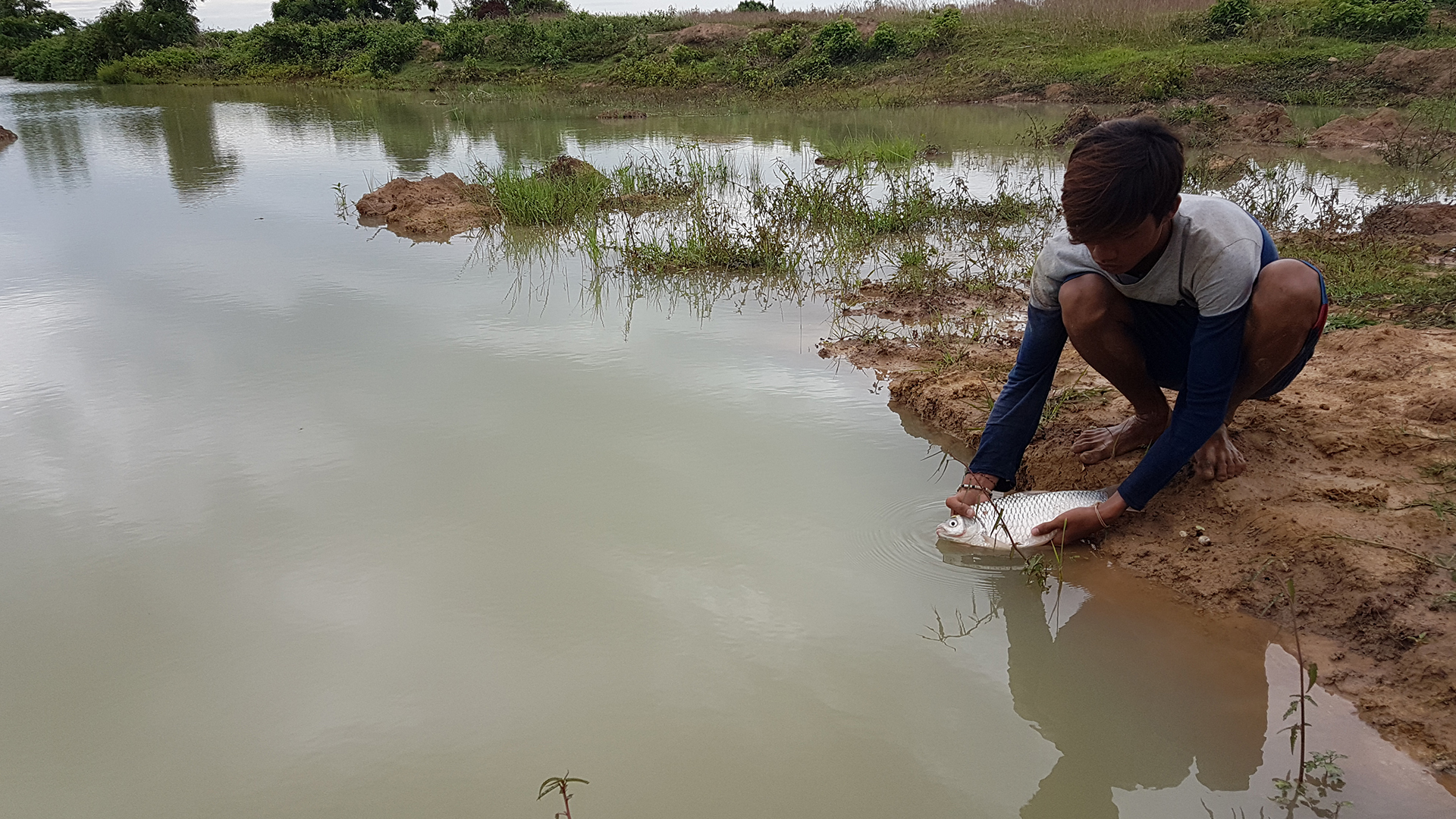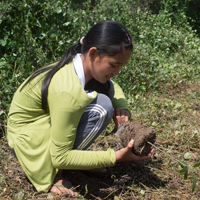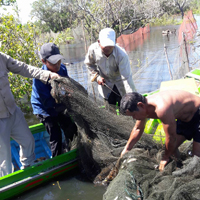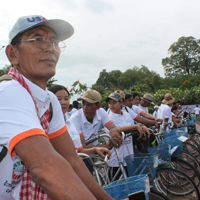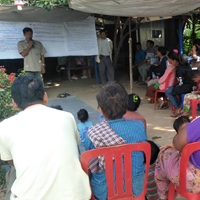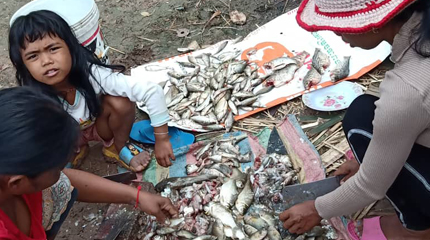
Sustainable Development and Natural Resource Management by Community Based Organizations
Funded from Forum Syd has supported 12 partner community fisheries in Battambang and Banteay Meanchey in wetland areas that are influenced by Tonle Sap lake. Partner communities have worked and collaborated well with other CSO and sub-national agencies to improve fish and species conservation. The grant is provided through a yearly grant agreement and provides for annual activities to prevent illegal fishing and hunting activities, clearing of forestland, natural lakes, and public fishing areas for creating rice fields. The project has operated for a second year 2 under co-funding by the Forum Syd-SIDA project and have been joined network capacity sharing information through governing committee team (GC) and around the Tonle Sap lake. We have worked on fish and species conservation, wetland forest conservation and protected wetland sustainable use areas, and patrolled a number of natural lakes. A number hectares of floodplain habitats were selected for community project areas where the project is being coordinated by line agencies and have been proposed in the Community Investment Plan (CIP). VSG has been working with fisheries since the fisheries reform in 2000-1 enabled fishing lots in Battambang and Banteay Meanchey to be released for villagers. The need for advocacy activities has increased year to year because of conflict between fishing lot owners and local poor fishers, while demand and value of the fresh fisheries resource has increased in Cambodia.
Governance Committees (GC), community committees, and Village Suport Group (VSG) have worked together to achieve the expected 3-objectives under outcome., Each partner submitted annual activities and a budget plan to VSG, broke down the activities and budget plan by each month and VSG allocated budget for field work every month. GC members have monitored the budget expenditure, progress reporting and have joined field demonstrations to solve the fishing challenges. The partners have also measured their capacity and project implementation through local capacity self-assessment that are made every year, and these self-assessment processes engage with grassroots members and the audience so they can provide their evaluation inputs. The findings of the 2017 results show that 12 partner communities have achieved their annual activities, their internal management is better, men and women are good in joining with fish and species conservation, local fishers and harvesters have a good understanding of biodiversity conservation, they have stopped the use of illegal fishing gear and prevented other illegal activities such as clearing of forestland and burning forests for hunting. Fish and aquatic animal conservation areas have provided safety for fish, water in the lakes has been well managed, 487 natural lakes/public fishing lakes are controlled by communities including 641.50 hectares (increased 105 hectares in 2017) wet-forest conservations, 9 fish refuge ponds (increased 1 pond in 2017) have been created, those partner CBOs have increased hectares of habitats for fish and species well condition. Habitats in fishing areas are more stable or increased among the partner CBO fishing areas. Fishers have caught fish in the rice fields and floodplain area, and they have harvested non-timber forest products in wetland forest areas and no one has restricted their legal fishing and harvesting.
Context and Development
The Great Lake is known as Tonle Sap and has a surface area of 2,500 Km2 in the dry season, which expands to 15,000 km2 during the rainy season. It influences the flow of flood water and fish to VSG’s target areas in or around July to November, and then flood waters leaving down to Tonle Sap. The public fishing areas such as lakes, rivers, and streams of the provinces have provided an average of more than 40 kg of fish for consumption per capita per year, excluding aquatic animals such as freshwater crabs, frogs and snails which villagers have caught in the rice field or wetland. VSG has also been working with villagers in upland areas that do not have natural wetland areas to access the fish from fish refuge ponds, rivers, and reservoirs, and to access non-forest timber products. Target community people eat more fish than people in the cities - rural poor households usually catch, on average, 2-3 kg of fish and aquatic animals per time, particularly in October and February. Fish and aquatic animals are a nutritious source of protein for villagers in these target areas. However, the level of household dependency on fisheries as a source of income varies widely according to the conditions and seasonality of fish and flooded forest conservation and fish supplies from other sources such as from rice fields, fish ponds and other public fishing areas.
Geography
Villagers have changed their behaviours’ and participation has increased for biodiversity conservation activities. Those participating have included politicians within the political systems. Fish and other species have increased in fish conservation areas and fish refuge ponds, plants have increased in the community areas. There are not only fishers conducting fishing activities from inside the communities, but also a number of fishers from upland areas coming to catch fish and harvest woods without fishing and wood harvesting, villagers have grown yields of other crops, with a hope to stabilise water, forest and soil quality through nature. Outside of our control, the wetland community is increasingly seeing lakes dry up in the dry season because rain is not as regular over the past last ten years, and water from Tonle Sap, observed by local villagers, is not flooding high enough for water to flow in. There have houses in wetland/zone 3 and zone 1 but it has no house in zone 2 (notice that in the Tonle Sap lake, the authority of Tonle Sap has divided 3 zones areas, zone 1 is next to large lake of Tonle Sap, and zone 2 is next to upland and zone 3 is in the middle). They have no any industry, but they have fishers come to catching fish and harvest wood for a few days or weeks by season and then go back home.
Villagers and community characteristics of learning and understanding the interrelationships between local villagers and their environments has increased. It has increase because their cropping depends on good water and soil quality.. Farmers have harvested the natural vegetation by keeping the sources, this is one of changing of VSG Forum Syd MAC funding project that they really understanding the natural environment is importance for their livelihood and, as a result, villagers have contributed their labour, money, and also raised extra money. They have used this for lake rehabilitation or modification to store more water in dry season, and built irrigation for water flow from reliable sources of water direct to fish/species conservation areas - this is one of best practice adopted by partners. Villagers have planted trees around the conservation lakes, applied flooded forest plantation activities and these trees have prevented soil erosion.

